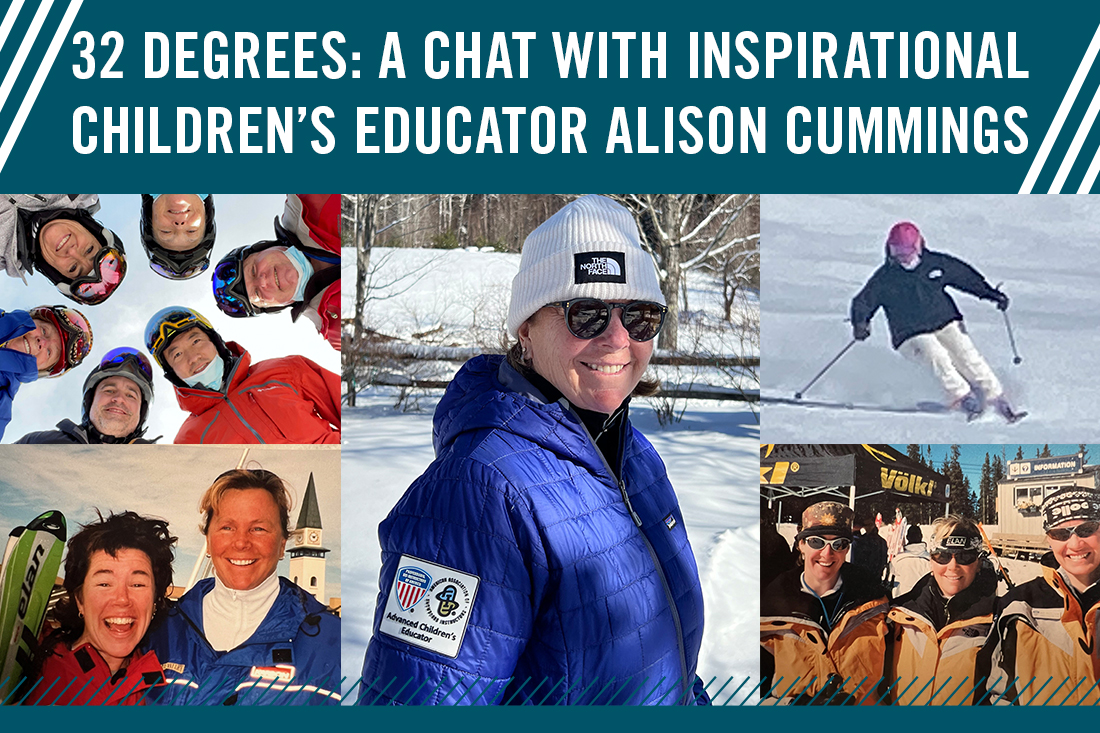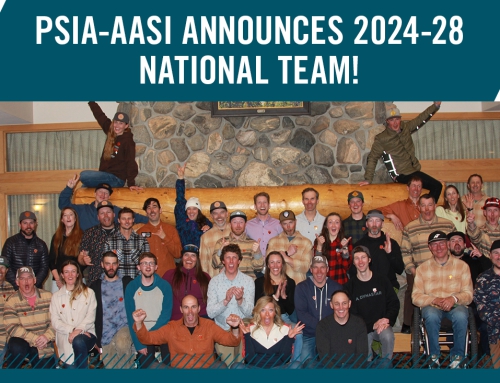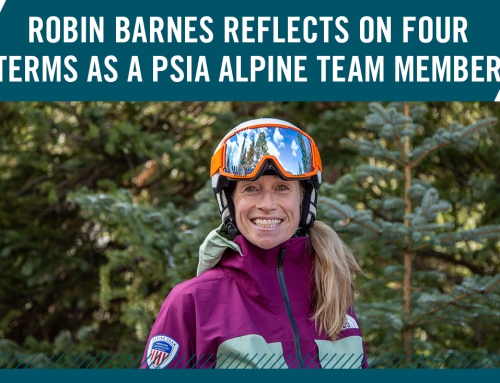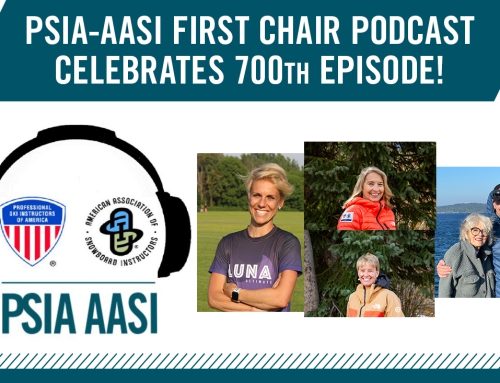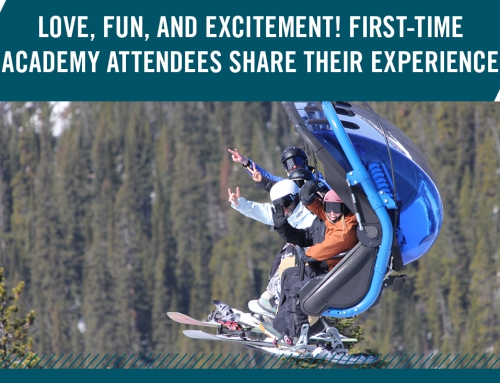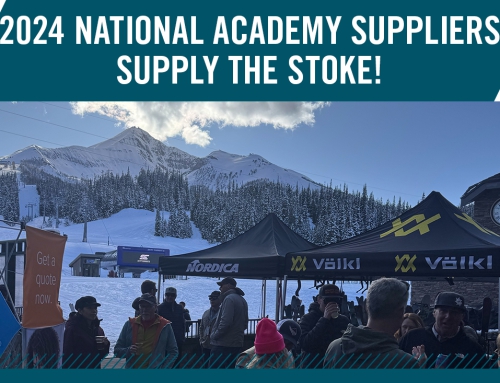32 Degrees: A Chat with Inspirational Children’s Educator Alison Cummings
This article by PSIA-AASI Education Development Manager Angelo Ross appears in the Spring 2024 Issue of 32 Degrees. You can read the entire digital edition by logging in and visiting the 32 Degrees page on our website. You can also pick up a copy of Teaching Children Snowsports: Alpine Field Guide, the newest resource for children’s instructors, in the PSIA-AASI Shop.
Alison Cummings, a longtime member of the PSIA-AASI Eastern Education Staff, has represented – and helped shape – excellence in snowsports education for more than 40 years. A recently retired alpine and children’s examiner, Alison was a member of PSIA’s Junior Education Team (JETs) – which, in the 1990s, helped develop some of the association’s earliest resources and training protocols for children’s instructors.
She was also instrumental in the development of Eastern’s Advanced Children’s Educator (ACE) Team and served as its first coach. Here, 32 Degrees gives readers a glimpse into insights Alison gleaned throughout her extraordinary career in snowsports.
Where do you currently live and what local resort do you frequent?
I live in Windham, Vermont, on a farm purchased by my grandparents in the 1930s. We are 20 minutes from five ski areas. My go-to resort is Stratton Mountain, and I ski at the others frequently.
What’s your favorite drill or warm-up activity to get to peak performance?
Hopping! In a straight run, into the turn, out of the turn, then through the whole turn. Hopping centers me, gets me feeling accurate inside my boots, grounds my feet in the middle of my skis, and warms up the muscles.
What’s the most gratifying experience in your career?
I loved working as part of the Junior Education Team, or JETs. Selected from regions across the United States, we created protocol for teaching children when many snowsports schools were lumping kids in with adults. As a group of individuals with a variety of strengths, we meshed into a functional, creative, and productive team.
The Children’s Academies we hosted, clinics we ran, equipment we helped design for kids, and the Children’s Manual we created were the result of some of the most inspirational collaboration I have ever been a part of. It was an honor to work with each one of the JETS over the 11 years I was on the team.
How has children’s instruction – and maybe children themselves – changed (and stayed the same) since your days as a member of the JETs?
The way we work with children and the programs we offer is at the forefront of snowsports instruction. The resources available are abundant, with teams like the Advanced Children’s Educators in the Eastern Region always working to be on the cutting edge of what’s happening with children and development. Strategies have evolved to better engage children raised in the digital age, risk-takers (who gravitate to snowboarding and freestyle skiing), and those who benefit from seasonal programs that enhance social interaction. One huge change is the overall awareness that children are a pivotal part of the snowsports business. The survival of our industry depends on developing kids into lifelong participants.
What’s the biggest difference – and similarity – between teaching kids and adults?
I like to reference the CAP Model (thank you, JETS, for this) when I compare kids to adults. Based on where people are in their cognitive, affective, and physical development, an instructor can help target any lesson for the person they are working with.
One difference I see is that kids typically require less explanation and more movement whereas an adult might want more detailed information and to take things step by step. Of course, there are many exceptions and using the CAP Model as a guideline can create meaningful learning experiences for all ages.
What’s your favorite lesson to teach?
I have several favorite lessons to teach. The first is the 4-year-old who is agile and strong enough to kick a soccer ball. This child is typically a fast learner and excited as they progress!
My second favorite is any ski instructor who has a base of knowledge and wants to learn more. Whether it’s about teaching or technique, I love working with instructors to help them gain a better understanding of what we do on snow and why.
And finally, I love teaching women at all levels! It’s been very rewarding to share knowledge, help instill confidence, and, in some cases, empower women to move into leadership roles.
What’s your best advice to someone training to level up their certification?
Understand what will be expected at the assessment. Talk to local education staff or colleagues who have taken the assessment level you are targeting. Be sure you understand what is being assessed, as there are multiple parts. Practice the parts before the assessment so you have confidence going in.
How can someone evaluate and work to improve their people skills?
Engage students and peers in your development. If you’re working on listening skills, for instance, let your students know. Make it a two-way process where they can let you know if you’re hitting the mark. And likewise, be specific in telling your peers what you’re trying to improve, so they can help keep you on task. Expect and accept their feedback!
I also recommend having someone film you while you’re coaching. Then play back the video and listen to how you engage with your students. This can be very enlightening! Pay attention to your tone of voice, your body language, your pacing, and your inclusion of group members.
What’s your best advice for creating learning environments based on play, experimentation, and exploration?
Engage your students in the moment and in the experience. My most successful lessons happen when people (of any age) have some skin in the game. Invite them to take part in the decision-making. Maybe they select a type of terrain, or a turn shape, or an activity. Involve them in a group discussion to gauge the success of the outcome. Have them share what they discover. This allows the instructor to determine if concepts are sinking in, while having the students actively engaged in the learning process.
What opportunities are there in the snowsports industry?
There are so many options now for a person who wants a career in snowsports, from college programs and PSIA-AASI leadership tracks to industry partner programs. And the path to management in the snowsports industry has been cleared for women by some amazing role models. There are abundant leadership training programs, mentorships, and development opportunities that didn’t exist 30 years ago.
What role will snowsports play in your life moving forward?
Retiring from being an active examiner was one of the most difficult decisions I have ever made. I love my work as a member of the Eastern Region’s board of examiners and will miss it terribly. I have a passion for teaching and helping others. That said, I will spend my time skiing with friends and family and hopefully do a bit of coaching whenever possible!

